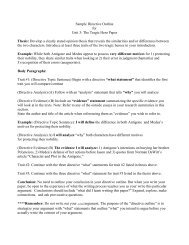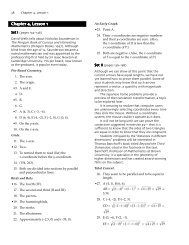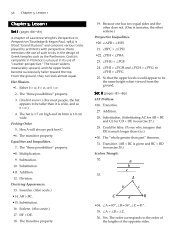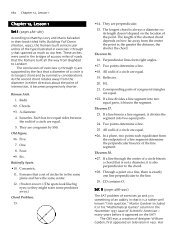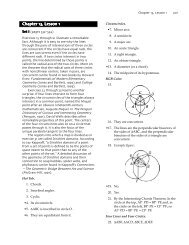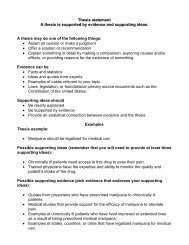10.3 Regulating the Cell Cycle
10.3 Regulating the Cell Cycle
10.3 Regulating the Cell Cycle
You also want an ePaper? Increase the reach of your titles
YUMPU automatically turns print PDFs into web optimized ePapers that Google loves.
Name Period Lab #<strong>10.3</strong> <strong>Regulating</strong> <strong>the</strong> <strong>Cell</strong> <strong>Cycle</strong>Lesson ObjectivesDescribe how <strong>the</strong> cell cycle is regulated.Explain how cancer cells are different from o<strong>the</strong>r cells.Lesson SummaryControls on <strong>Cell</strong> Division Dozens of proteins regulate <strong>the</strong> cell cycle.Cyclins are proteins that regulate <strong>the</strong> timing of <strong>the</strong> cell cycle in eukaryotic cells.Regulatory proteins work both inside and outside of <strong>the</strong> cell. Internal regulators allow <strong>the</strong> cell cycle to proceed when certain events have occurredwithin a cell. External regulators called growth factors stimulate <strong>the</strong> cell cycle. O<strong>the</strong>r externalregulators cause <strong>the</strong> cell cycle to slow down or stop.Apoptosis is programmed cell death that plays a key role in <strong>the</strong> development of tissuesand organs.Cancer: Uncontrolled <strong>Cell</strong> Growth Cancer is a disorder in which cells divideuncontrollably, forming a mass of cells called a tumor.Cancers are caused by defects in genes that regulate cell growth.Treatments for cancer include: removal of cancerous tumors. radiation, which interferes with <strong>the</strong> copying of DNA in multiplying cancer cells. chemo<strong>the</strong>rapy, which is <strong>the</strong> use of chemicals to kill cancer cells.Controls on <strong>Cell</strong> DivisionFor Questions 1–6, write True if <strong>the</strong> statement is true. If <strong>the</strong> statement is false,change <strong>the</strong> underlined word or words to make <strong>the</strong> statement true.1. <strong>Cell</strong>s tend to continue dividing when <strong>the</strong>y come into contact with o<strong>the</strong>rcells.2. <strong>Cell</strong> division speeds up when <strong>the</strong> healing process nears completion.3. Proteins called growth factors regulate <strong>the</strong> timing of <strong>the</strong> cell cycle ineukaryotic cells.4. If chromosomes have not attached to spindle fibers during metaphase,an internal regulatory protein will prevent <strong>the</strong> cell from enteringanaphase.5. Growth factors are external regulatory proteins that slow down <strong>the</strong> cellcycle.6. Once apoptosis is triggered, a cell proceeds to self-destruct.
7. Complete <strong>the</strong> cause-and-effect chart by giving an example of an effect caused by eachtype of regulatory protein.Factors Affecting <strong>the</strong> <strong>Cell</strong> <strong>Cycle</strong>CauseEffectCyclinsInternal regulatory proteinsExternal regulatory proteinsCancer: Uncontrolled <strong>Cell</strong> Growth8. What is cancer?9. What are <strong>the</strong> two basic types of tumors? Explain how <strong>the</strong>y are different.10. Why can cancer be life threatening? Include how <strong>the</strong>y can move into <strong>the</strong> bloodstream.
11. What is <strong>the</strong> cause of cancer?12. How do radiation and chemo<strong>the</strong>rapy affect cancer cells?13. Fill out <strong>the</strong> flowchart by completing each statement with <strong>the</strong> correct word or words.Cancer cells do not respond to signals that regulate cell .Cancer cells form a mass of cells called a .Cancer cells may break loose andthroughout <strong>the</strong> body.Cancer cells form tumors in o<strong>the</strong>r tissues by .Apply <strong>the</strong> Big idea14. Hair grows from hair follicles, pockets of continually dividing cells in <strong>the</strong> outer layer of<strong>the</strong> skin. New cells are added to <strong>the</strong> base of a hair shaft, inside each follicle. Use what youhave learned in this lesson to explain why cancer patients often lose <strong>the</strong>ir hair whenreceiving chemo<strong>the</strong>rapy and grow more hair after chemo<strong>the</strong>rapy stops.
Name Period Lab#10.4 <strong>Cell</strong> DifferentiationLesson ObjectivesDescribe <strong>the</strong> process of differentiationDefine stem cells and explain <strong>the</strong>ir importance.Identify <strong>the</strong> possible benefits and issues relating to stem cell research.Lesson SummaryFrom One <strong>Cell</strong> to Many Multicellular organisms produced via sexual reproductionbegin life as a single cell.Early cell divisions lead to <strong>the</strong> formation of an embryo.Then, individual cells become specialized in both form and function through <strong>the</strong> processof differentiation.Once cells of a certain type, such as nerve cells or muscle cells, have formed, <strong>the</strong> cellscannot develop into a different type of cell.Stem <strong>Cell</strong>s and Development During an organism’s development, some cellsdifferentiate to become a wide variety of body cells.A fertilized egg and <strong>the</strong> first few cells in an embryo are able to form any kind of cell andtissue. Such a cell is termed totipotent.A blastocyst is an embryonic stage that consists of a hollow ball of cells. These cells areable to become any type of body cell. Such cells are termed pluripotent.Unspecialized cells that can develop into differentiated cells are called stem cells. Stemcells are found in embryos and in adults. Embryonic stem cells are <strong>the</strong> pluripotent cells of an early embryo. Adult stem cells are multipotent, which means <strong>the</strong>y can produce many, but not all,types of differentiated cells.Frontiers in Stem <strong>Cell</strong> Research Scientists want to learn about <strong>the</strong> signals that tell acell to become ei<strong>the</strong>r specialized or multipotent.Potential benefits of stem cell research include <strong>the</strong> repair or replacement of damaged cellsand tissues.Research with human stem cells is controversial because it involves ethical issues of lifeand death.From One <strong>Cell</strong> to ManyFor Questions 1–4, complete each statement by writing <strong>the</strong> correct word or words.1. Humans, pets, and petunias all pass through an early stage of development calleda(n) .2. <strong>Cell</strong>s become through <strong>the</strong> process of differentiation.
3. Scientists have mapped <strong>the</strong> outcome of every that leads todifferentiation in <strong>the</strong> development of <strong>the</strong> microscopic worm C. elegans.4. Most cells in <strong>the</strong> adult body are no longer capable of .Stem <strong>Cell</strong>s and DevelopmentFor Questions 5–7, write <strong>the</strong> letter of <strong>the</strong> correct answer on <strong>the</strong> line at <strong>the</strong> left.5. Which is an example of a totipotent cell?A. blastocystB. bone cellC. fertilized eggD. lymphocyte6. <strong>Cell</strong>s that are pluripotent are unable to develop into <strong>the</strong> tissue thatA. forms <strong>the</strong> skin.B. lines <strong>the</strong> digestive tract.C. produces blood cells.D. surrounds an embryo.7. Adult stem cells are best described asA. multipotent.B. pluripotent.C. totipotent.D. unable to differentiate.8. Complete <strong>the</strong> concept map by identifying some of <strong>the</strong> types of cells that embryonic stemcells give rise to. Then explain how stem cells are like <strong>the</strong> stem of a plant.Embryonic Stem<strong>Cell</strong>scan become
Frontiers in Stem <strong>Cell</strong> ResearchFor Questions 9–11, write <strong>the</strong> letter of <strong>the</strong> correct answer on <strong>the</strong> line at <strong>the</strong> left.9. Which is not a new, potential benefit of stem cell research?A. growing new skin cells to repair a cutB. replacing heart cells damaged by heart attacksC. repairing breaks between nerve cells in spinal injuriesD. preventing suffering and death caused by cellular damage10. What is <strong>the</strong> main reason that embryonic stem cell research is consideredethically controversial?A. growing new skin cells to repair a cutB. replacing heart cells damaged by heart attacksC. repairing breaks between nerve cells in spinal injuriesD. preventing suffering and death caused by cellular damage11. What is one new technology that could make stem cell research lesscontroversial?A. implanting skin cells instead of stem cells in damaged tissueB. developing <strong>the</strong> ability to switch on <strong>the</strong> genes that make an adult cellpluripotentC. replacing stem cells with cancer cellsD. using <strong>the</strong> Internet to get more people to accept stem cell researchApply <strong>the</strong> Big idea12. Many plants such as orchids are grown by a technique called tissue culture. Small piecesof plant tissue from a leaf, stem, or root of a mature plant are placed in a medium thatcontains <strong>the</strong> proper nutrients. The cells first form a mass of undifferentiated cells, fromwhich tiny roots, stems, and leaves eventually grow. How do <strong>the</strong> plant cells placed in amedium for tissue culture change in terms of <strong>the</strong>ir degree of specialization? What typesof animal cells are most similar to <strong>the</strong> undifferentiated plant cells in a tissue culture?Explain your answer.




